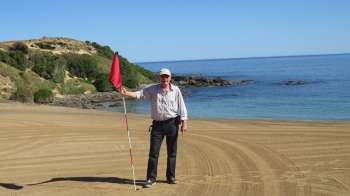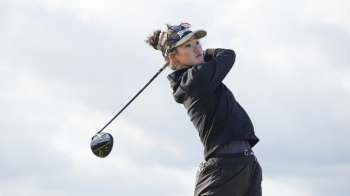Ever since I can remember I wanted a backyard putting green. Not just any green, but one with contour and slope that would allow for all sorts of putts, of both decent length and decent break. With the arrival of the synthetic putting green the dream got closer, but also more confusing. The last thing I wanted was a pancake flat green, or worse, something with a funky shape that nobody used because it was impossible to putt on. The balance is more difficult to get right with synthetic grass than real grass, because you can’t adjust mowing heights or change maintenance practices. That’s the appeal of maintenance free lawn, but it’s also the problem. The grass you install is the grass that you live with – so get your green wrong and you live with the mistake every single day.

Above - The Planet Golf Backyard Putting Green
As you’ll see in the before pictures, I had an overgrown backyard full of kikuyu and weeds that was especially difficult to maintain given I am often away for weeks, or months, at a time. Each year it seemed to get worse. The idea of a synthetic putting green in the backyard appealed on several fronts. Firstly as a great excuse to get my three kids outside more often, and to introduce them to the game that I love. It would also hopefully improve the weakest part of my game, and become a feature that friends and family could enjoy.

The key in my mind from the outset was interesting breaks and to create enough variety that the kids don’t get bored with golf. In order to shape a green with enough movement for fun putting, you need to make sure that the turf you install does not get too quick. Here is the frustration with synthetic putting lawns, they all look great when first installed but they also all use a sand infill to hold the turf down and provide a smoother roll. As that sand gets wet it starts to compact, and eventually you end up with a rock hard green running at 14-15 on the stimpmeter. Unless you have an enormous area for your putting green, a surface that quick is going to need to be flat or it becomes unplayable. The last thing I wanted was flat.
After nearly 3 years studying synthetic greens and sampling the various lawns on the market I stumbled across an Australian made product called Supreme Green by a company called ProGrass. Developed by veteran synthetic turf expert Bruce Warwick, the ProGrass product is the only putting grass on the market that doesn’t use a sand infill. It uses something called Profill, a recycled byproduct that does not compact like sand when wet and is less likely to attract mould. The performance initially is the equal of sand, with balls rolling true and responding just like a real green to chip and pitch shots. After nearly four months in play, I can confirm that the Profill only gets better with each use. A light brush from time to time keeps the putting surface smooth, and Bruce did a great job with his quantities making sure that we had enough infill for a 9-10 stimpmeter speed. You can make the green faster if you want.
There are very few levels putts on our green, and while downhill putts are tricky they are not crazy quick and unplayable. Kids seem to love the longest putts best (45 feet approx) while adults prefer the sharp breaking 15 footers at the top of the green. We have five holes in total, and you can practice all manner of putts – including double breakers, uphill left-to-right and right-to-left putts and downhill left-to-right and right-to-left putts. There are putts that break hard, putts that break soft and putts that head both sharply and gently uphill and down. Variety and fun were the most important factors for us, and thankfully the ProGrass Supreme Green turf has the ability to be contoured and shaped to fit any design you want.
That design was developed with help from the Turnpoint company, who are Australia’s leading golf course builder. It was Turnpoint’s job to clear my yard and prepare the green base for the putting surface according to the plan. The process involved the removal of all our grass and green waste to create an open space and level area.

Above - The backyard is excavated and (right) the crushed rock imported to create the putting green.
Next was a thick layer of crushed rock and finally the bedding sand on top. The bedding sand is great because it not only helps with drainage but it allows for refinements to be made to the shapes once the crushed rock is in place. We only made one serious change, and that was to slightly soften the middle section of the green to create an additional pin placement.

Above - Bruce from ProGrass levelling the bedding sand, and (right) dusting the yard with infill.

Above - Bruce brushing in the Infill, and (right) the finished product without the garden beds.
As you can see in the pictures below, the transformation has been stark – from an unsightly, unloved and unusable space to a backyard that has become a centerpiece and a magnet for neighbouring friends and family. It’s also been an effective tool for getting kids outside having fun. While they don’t always use it for golf, the fact that ProGrass offer the only Australian made synthetic products on the market and those products are UV protected and without nasty chemicals gives peace of mind regardless of what they are doing.

Surrounding our green is a synthetic landscape grass known as Australian Gold, one of the most popular synthetic lawns in Australia and, importantly, one of the most realistic looking. Whether the kids are out there playing basketball, cricket, tennis, (outdoor) chess or simply reading a book, the backyard is being used and that was the aim from the outset. Pleasingly, we’ve noticed that there are fewer insects outside with the grass gone and the lawn itself is not as hot in summer as we feared. On a 40+ day you probably need thongs on the putting green, but otherwise it’s no problem being out there in bare feet.
There are endless options when it comes to synthetic lawn at the moment, and any number of ways to go about building a backyard putting green. Given the increasing popularity of fake grass and low maintenance yards in general, I wanted to put this case-study up on Planet Golf to potentially help other keen golfers looking at a backyard makeover. Some may be interested in speed and a different ‘look’, but for a performance putting turf that keeps its speed and can be shaped any way you want, it’s worth considering the ProGrass products. They are very competitively priced, Australian made, chemical free, UV protected and realistic to putt on and chip to.
Additionally, we can‘t speak highly enough of Bruce’s professionalism and ProGrass's customer service. Not only did Bruce personally lay our turf and the Profill infill, but he returned a few weeks later to apply another dusting of the infill and make sure we were completely happy with the yard.
My only regret when it comes to our backyard putting green is that we didn’t do it sooner.

Above - Planet Golf's Backyard Putting Green, fun for the entire family.
I’m happy to respond to any queries golfers have about synthetic grass, and our backyard putting green. Email darius@planetgolf.com.au with your questions or comments.
Darius Oliver



